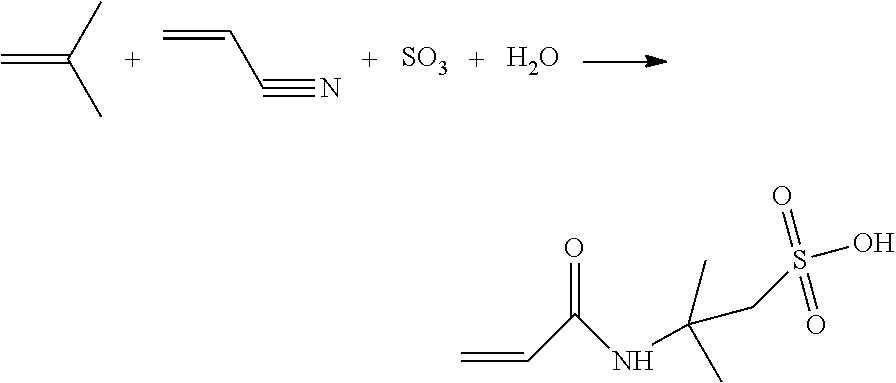New method for producing 2-acrylamido-2-methylpropane sulphonic acid
- Summary
- Abstract
- Description
- Claims
- Application Information
AI Technical Summary
Benefits of technology
Problems solved by technology
Method used
Image
Examples
example 1
[0123]1522 g of acrylonitrile containing 0.4% by weight of water and 180 g of fuming sulfuric acid titrating 104% H2SO4 (18% oleum) were added to a stirred 2000 mL double-wall reaction vessel. The resulting sulfonating mixture was stirred for one hour and cooled by the double wall of the reaction vessel which kept the temperature of the sulfonating mixture at −20° C.
[0124]97 g of isobutylene was added to the preceding sulfonating mixture at a flow rate of 1.6 g per minute. The temperature of the resulting reaction mixture was held at 45° C. during addition of the isobutylene. The 2-acrylamido-2-methylpropane sulfonic acid particles precipitated in the reaction mixture and the proportion of 30 solids was about 20% by weight.
[0125]The reaction mixture was filtered on a Büchner type filter; the resulting composition 1 contained 70% particles.
[0126]100 g of water, representing the aqueous solution A, was placed in a 500 mL stirred reaction vessel. The composition 1 recovered on the Büch...
example 2
[0129]The conditions for obtaining composition 1 were identical to example 1.
[0130]100 g of liquid resulting at the end of example 1, representing the aqueous solution A, was placed in a 500 mL stirred reaction vessel. Composition 1, undried on the Büchner filter, was added to the reaction vessel. The temperature was held at room temperature, meaning 25° C.
[0131]After three hours in suspension, the resulting suspension 1 was filtered on a Büchner type filter. The resulting composition 2 was undried and 340 g of ATBS was recovered. The yield was 91% relative to the isobutylene.
[0132]138 g of liquid containing water, acrylonitrile, sulfuric acid and 2-acrylamido-2-methylpropane sulfonic acid was recovered.
example 3
[0133]1215 g of acrylonitrile containing 0.2% by weight of water, 130 g of sulfuric acid (98% concentration) and 130 g of fuming sulfuric acid titrating 105.62% H2SO4 (25% oleum) were added to a stirred 2000 mL double-wall reaction vessel. The resulting sulfonating mixture was stirred for one hour and cooled by the double wall of the reaction vessel which kept the sulfonating mixture at −20° C.
[0134]135 g of isobutylene was added to the preceding sulfonating mixture at a flow rate of 1 g per minute. The temperature of the resulting reaction mixture was held at 40° C. during addition of the isobutylene. The 2-acrylamido-2-methylpropane sulfonic acid particles precipitated in the reaction mixture and the proportion of solids was about 30% by weight.
[0135]The reaction mixture was filtered on a Büchner type filter; the resulting composition 1 contained was 70% crystals.
[0136]120 g of water, representing the aqueous solution A, was placed in a stirred 1000 mL reaction vessel. The composi...
PUM
| Property | Measurement | Unit |
|---|---|---|
| temperature | aaaaa | aaaaa |
| temperature | aaaaa | aaaaa |
| temperature | aaaaa | aaaaa |
Abstract
Description
Claims
Application Information
 Login to View More
Login to View More - R&D
- Intellectual Property
- Life Sciences
- Materials
- Tech Scout
- Unparalleled Data Quality
- Higher Quality Content
- 60% Fewer Hallucinations
Browse by: Latest US Patents, China's latest patents, Technical Efficacy Thesaurus, Application Domain, Technology Topic, Popular Technical Reports.
© 2025 PatSnap. All rights reserved.Legal|Privacy policy|Modern Slavery Act Transparency Statement|Sitemap|About US| Contact US: help@patsnap.com

